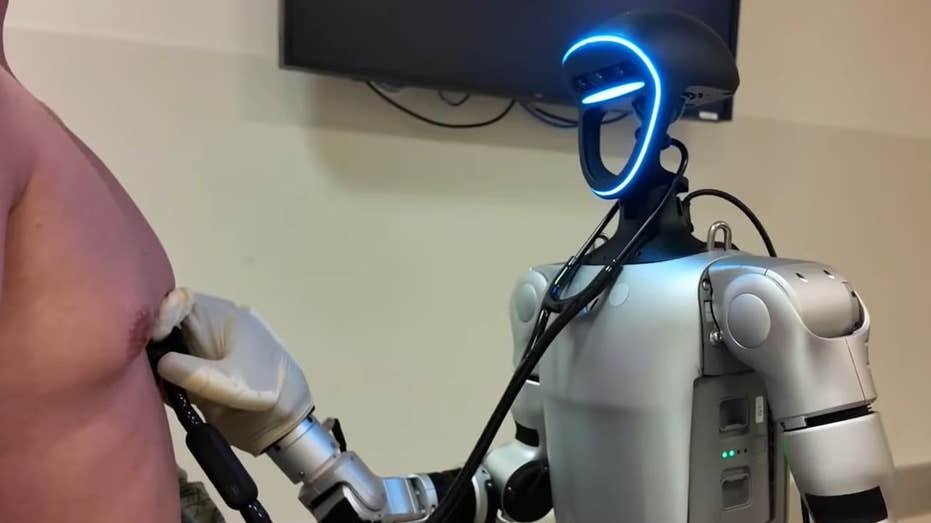Healthcare systems worldwide are struggling with overcrowded hospitals, physician burnout, and rising surgery delays. Which is why it’s always a good thing to see research exploring new solutions through technology. The University of California San Diego (UCSD) is looking into humanoid robots as a potential solution. It suggests they might play a vital role in easing medical burdens. Unlike traditional surgical robots that are expensive and highly specialized, humanoid robots offer more flexibility. And this makes them promising candidates for a wide range of clinical tasks.
Sign up for my FREE CyberGuy Report
Get my best tech tips, urgent security alerts, and exclusive deals delivered straight to your inbox. Plus, you’ll get instant access to my Ultimate Scam Survival Guide – free when you join my CYBERGUY.COM/NEWSLETTER.
UCSD equipped a Unitree G1 humanoid robot with Inspire Gen4 robotic hands and developed a bimanual teleoperation system for it as well. Both allow it to perform seven varied medical procedures using a remote control operated by a human using foot pedals, HTC Vive trackers, and motion-capture cameras.
These tasks the robot carried out ranged from physical exams like auscultation and palpation, to emergency procedures such as Bag Valve Mask ventilation and endotracheal intubation. Some of them even required a great deal of precision, like ultrasound-guided injections.
There were some challenges with force control and sensor sensitivity, but the robot managed to carry out most tasks given to it with accuracy.
For examinations, it successfully used a stethoscope and performed basic physical examinations. In these tests, performance was hindered by limitations in sensor feedback and hand design. For emergency care, it achieved consistent ventilation. However, it required human assistance to maintain the necessary seal and force required for intubation.
When it came to needle procedures, it performed ultrasound-guided injections. It achieved a 70% success rate when performed by non-clinicians, demonstrating its potential for training purposes. Trials showed issues with needle control and orientation during suturing, indicating that the haptic feedback mechanisms need improvement.
This is the first major study to add humanoid robots to hospital work systems. With aging populations and ongoing labor shortages, these adaptable robots could support routine and emergency tasks in hospital settings. This robot could take immense pressure off medical staff. The versatility and ability to be remotely controlled make it particularly appealing for settings that require rapid response and tools that can carry out a wide range of tasks.
If you’ve ever waited too long in an ER, struggled to book a specialist appointment, or worried about overworked healthcare providers, this research should catch your attention. Humanoid robots like the Unitree G1 aren’t replacing doctors, but they could support them in real, practical ways. From performing emergency procedures in remote areas to helping with routine physical exams in crowded hospitals, these robots could ease bottlenecks and improve care access.
For patients, that could mean shorter wait times, faster treatment, and safer hospital environments where medical teams are less stretched. For families in rural or underserved areas, this technology could offer critical care support where medical staff is limited. And for healthcare workers, it could bring much-needed relief by taking on repetitive or physically taxing tasks.
While the tech is still evolving, these early results suggest a future where hospitals have robotic teammates, not just tools, helping deliver faster, smarter care.
While humanoid robots like the Unitree G1 are not ready to fully replace humans, they’re steadily proving how capable they are in medical environments. The researchers just need to solve issues like force control, sensitivity, and dexterity. Once they do, we will see these robots in operating rooms around the world assisting with surgeries. They will make our struggling healthcare systems far more resilient and accessible.
Would you let a humanoid robot handle your healthcare needs? Let us know by writing us at Cyberguy.com/Contact.
Sign up for my FREE CyberGuy Report
Get my best tech tips, urgent security alerts, and exclusive deals delivered straight to your inbox. Plus, you’ll get instant access to my Ultimate Scam Survival Guide – free when you join my CYBERGUY.COM/NEWSLETTER.
Copyright 2025 CyberGuy.com. All rights reserved.
Latest & Breaking News on Fox News

